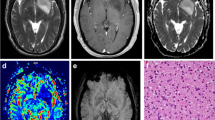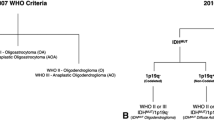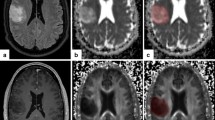Abstract
Objectives
To explore the correlations of conventional MRI (cMRI) and diffusion tensor imaging (DTI) values with the 1p/19 codeletion and IDH mutations in oligodendroglial tumours (OTs).
Methods
Eighty-four patients with OTs who underwent cMRI and DTI were retrospectively reviewed. The maximal fractional anisotropy and minimal apparent diffusion coefficient (ADC) were measured and compared using the Mann-Whitney U test. Receiver operating characteristic curves, logistic regression analysis and four-table statistics analysis were performed to predict genotypings.
Results
OTs with 1p/19q codeletion or IDH mutations were prone to locate in frontal (P = 0.106 and 0.005, respectively) and insular lobes and were associated with absent or blurry contrast enhancement (P = 0.040 and 0.013, respectively). DTI values showed significant differences between OTs with and without IDH mutations (P < 0.05) but not in OTs with and without 1p/19q loss. The Ki-67 index significantly correlated with IDH mutations (P = 0.002) but not with 1p/19q codeletion. A combination of DTI and cMRI for the identification of IDH mutations resulted in sensitivity, specificity, positive and negative predictive values of 92.2 %, 75.8 %, 93.8 % and 71.1 %, respectively.
Conclusions
Combination of DTI and cMRI correlates with isocitrate dehydrogenase 1/2 mutations but not 1p/19q genotyping in OTs.
Key Points
• OTs with 1p/19q codeletion were associated with absent or blurry contrast enhancement
• OTs with IDH mutations were also associated with absent or blurry contrast enhancement
• OTs with IDH mutations were prone to locate in frontal and insular lobes
• DTI values can provide a non-invasive method for assessing the IDH status of OTs
• A combination of DTI and cMRI correlates with isocitrate dehydrogenase 1/2 mutations




Similar content being viewed by others
Abbreviations
- AUC:
-
Area under the curve
- cMRI:
-
Conventional MRI
- FA:
-
Fractional anisotropy
- IDH:
-
Isocitrate dehydrogenase
- OTs:
-
Oligodendroglial tumours
- rmADC:
-
Ratio of minimal ADC
- rmFA:
-
Ratio of maximal FA
References
Bromberg JE, van den Bent MJ (2009) Oligodendrogliomas: molecular biology and treatment. Oncologist 14:155–163
Reifenberger G, Kros JM, Louis DN, Collins VP (2007) Oligodendroglioma and Anaplastic oligodendroglioma. In: Louis DN, Ohgaki H, Wiestler OD (eds) WHO Classification of Tumors of the Central Nervous System. IARC, Lyon, pp 54–62
Jaeckle KA, Ballman KV, Rao RD, Jenkins RB, Buckner JC (2006) Current strategies in treatment of oligodendroglioma: evolution of molecular signatures of response. J Clin Oncol 24:1246–1252
van den Bent MJ, Brandes AA et al (2013) Adjuvant procarbazine, lomustine, and vincristine chemotherapy in newly diagnosed anaplastic oligodendroglioma: long-term follow-up of EORTC brain tumor group study 26951. J Clin Oncol 31:344–350
Cairncross G, Wang M, Shaw E et al (2013) Phase III trial of chemoradiotherapy for anaplastic oligodendroglioma: long-term results of RTOG 9402. J Clin Oncol 31:337–343
Yan H, Parsons DW, Jin G et al (2009) IDH1 and IDH2 mutations in gliomas. N Engl J Med 360:765–773
Watanabe T, Nobusawa S, Kleihues P, Ohgaki H (2009) IDH1 mutations are early events in the development of astrocytomas and oligodendrogliomas. Am J Pathol 174:1149–1153
Sanson M, Marie Y, Paris S et al (2009) Isocitrate dehydrogenase 1 codon 132 mutation is an important prognostic biomarker in gliomas. J Clin Oncol 27:4150–4154
Frenel JC, Leux C, Loussouarn D et al (2013) Combining two biomarkers, IDH mutationss and 1p/19q codeletion, to stratify anaplastic oligodendroglioma in three groups: a single-center experience. J Neurooncol 114:85–91
Jenkinson MD, Smith TS, Brodbelt AR et al (2007) Apparent diffusion coefficients in oligodendroglial tumors characterized by genotype. J Magn Reson Imaging 26:1405–1412
Fellah S, Caudal D, De Paula AM et al (2013) Multimodal MR Imaging (Diffusion, Perfusion, and Spectroscopy): Is It Possible to Distinguish Oligodendroglial Tumor Grade and 1p/19q Codeletion in the Pretherapeutic Diagnosis? AJNR Am J Neuroradiol 34:1326–1333
Jenkinson MD, Smith TS, Joyce KA et al (2006) Cerebral blood volume, genotype and chemosensitivity in oligodendroglial tumors. Neuroradiology 48:703–713
Tan WL, Huang WY, Yin B, Xiong J, Wu JS, Geng DY (2014) Can diffusion tensor imaging noninvasively detect IDH1 gene mutations in astrogliomas? A retrospective study of 112 cases. AJNR Am J Neuroradiol 35:920–927
White ML, Zhang Y, Yu F, Jaffar Kazmi SA (2011) Diffusion tensor MR imaging of cerebral gliomas: evaluating fractional anisotropy characteristics. AJNR Am J Neuroradiol 32:374–381
Cha S (2006) Update on brain tumor imaging: from anatomy to physiology. AJNR Am J Neuroradiol 27:475–487
Brander A, Kataja A, Saastamoinen A et al (2010) Diffusion tensor imaging of the brain in a healthy adult population: normative values and measurement reproducibility at 3T and 1.5T. Acta Radiol 51:800–807
Wang Y, Xiong J, Chu SG et al (2009) Rosette-forming glioneuronal tumor: report of an unusual case with intraventricular dissemination. Acta Neuropathol 118:813–819
Lass U, Hartmann C, Capper D et al (2013) Chromogenic in situ hybridization is a reliable alternative to fluorescence in situ hybridization for diagnostic testing of 1p and 19q loss in paraffin-embedded gliomas. Brain Pathol 23:311–318
Preusser M, Hoeftberger R, Woehrer A et al (2012) Prognostic value of Ki67 index in anaplastic oligodendroglial tumors--a translational study of the European Organization for Research and Treatment of Cancer Brain Tumor Group. Histopathology 60:885–894
Takano S, Tian W, Matsuda M et al (2011) Detection of IDH1 mutation in human gliomas: comparison of immunohistochemistry and sequencing. Brain Tumor Pathol 28:115–123
Bland JM, Altman DG (1986) Statistical methods for assessing agreement between two methods of clinical measurement. Lancet 1:307–310
Jenkinson MD, du Plessis DG, Smith TS, Joyce KA, Warnke PC, Walker C (2006) Histological growth patterns and genotype in oligodendroglial tumors: correlation with MRI features. Brain 129:1884–1891
Megyesi JF, Kachur E, Lee DH et al (2004) Imaging correlates of molecular signatures in oligodendrogliomas. Clin Cancer Res 10:4303–4306
German RB, Dehais C, Idbaih A et al (2014) Contrast enhancement in 1p/19q-codeleted anaplastic oligodendrogliomas is associated with 9p loss, genomic instability, and angiogenic gene expression. Neuro Oncol 16:662–670
Jolapara M, Patro SN, Kesavadas C et al (2011) Can diffusion tensor metrics help in preoperative grading of diffusely infiltrating astrocytomas? A retrospective study of 36 cases. Neuroradiology 53:63–68
Kitis O, Altay H, Calli C et al (2005) Minimum apparent diffusion coefficients in the evaluation of brain tumors. Eur J Radiol 55:393–400
Mori N, Ota H, Mugikura S, Takasawa C et al (2015) Luminal-type breast cancer: correlation of apparent diffusion coefficients with the Ki-67 labeling index. Radiology 274:66–73
Fudaba H, Shimomura T, Abe T et al (2014) Comparison of multiple parameters obtained on 3 T pulsed arterial spin-labeling, diffusiontensor imaging and MRS and the Ki-67 labeling index in evaluating glioma grading. AJNR Am J Neuroradiol 35:2091–2098
Fischer I, Gagner JP, Law M, Newcomb EW, Zagzag D (2005) Angiogenesis in gliomas: biology and molecular pathophysiology. Brain Pathol 15:297–310
Dogan BE, Gonzalez-Angulo AM, Gilcrease M, Dryden MJ, Yang WT (2010) Multimodality imaging of triple receptor-negative tumors with mammography, ultrasound, and MRI. AJR Am J Roentgenol 194:1160–1166
Uematsu T, Kasami M, Yuen S (2009) Triple-negative breast cancer: correlation between MR imaging and pathologic findings. Radiology 250:638–647
Kapoor GS, Gocke TA, Chawla S et al (2009) Magnetic resonance perfusion-weighted imaging defines angiogenic subtypes of oligodendroglioma according to 1p19q and EGFR status. J Neurooncol 92:373–386
Xu W, Yang H, Liu Y et al (2011) Oncometabolite 2-hydroxyglutarate is a competitive inhibitor of a-ketoglutarate-dependent dioxygenases. Cancer Cell 19:17–30
Olar A, Raghunathan A, Albarracin CT et al (2012) Absence of IDH1-R132H mutation predicts rapid progression of nonenhancing diffuse glioma in older adults. Ann Diagn Pathol 16:161–170
Wang S, Kim S, Chawla S et al (2009) Differentiation between glioblastomas and solitary brain metastases using diffusion tensor imaging. Neuroimage 44:653–660
Beppu T, Inoue T, Shibata Y et al (2005) Fractional anisotropy value by diffusion tensor magnetic resonance imaging as a predictor of cell density and proliferation activity of glioblastomas. Surg Neurol 63:56–61
Louis DN, Perry A, Burger P et al (2014) International Society Of Neuropathology-Haarlem consensus guidelines for nervous system tumor classification and grading. Brain Pathol 24:429–435
Acknowledgments
Ji Xiong and Wenli Tan contributed equally to this paper. The scientific guarantor of this publication is Daoying Geng. The authors of this manuscript declare no relationships with any companies whose products or services may be related to the subject matter of the article. This study has received funding from a grant from the National Nature Science Foundation of China (No. 81402051) to Ji Xiong, and the National Nature Science Foundation of China (No. 81471627), the Specialized Research Fund for the Doctoral Program of Higher Education of China (No. 20130071130011), and the Shanghai Health System Important Disease Joint Research Project (No. 2013ZYJB009) to Daoying Geng, and the National Nature Science Foundation of China (No. 81201071), the Science and Technical Committee of Shanghai Municipality (No. 12ZR1441600) and Outstanding Youth Grant from Shanghai Municipal Commission of Health and Family Planning (No. XYQ2013107) to Jun Zhang. Xiaoqin Wang kindly provided statistical advice for this manuscript. Institutional Review Board approval was obtained. Written informed consent was waived by the Institutional Review Board. Methodology: retrospective, experimental, performed at one institution.
Author information
Authors and Affiliations
Corresponding authors
Additional information
Ji Xiong and Wenli Tan contributed equally to this work.
Rights and permissions
About this article
Cite this article
Xiong, J., Tan, W., Wen, J. et al. Combination of diffusion tensor imaging and conventional MRI correlates with isocitrate dehydrogenase 1/2 mutations but not 1p/19q genotyping in oligodendroglial tumours. Eur Radiol 26, 1705–1715 (2016). https://doi.org/10.1007/s00330-015-4025-4
Received:
Revised:
Accepted:
Published:
Issue Date:
DOI: https://doi.org/10.1007/s00330-015-4025-4




